Streamlight introduced the TLR-4™G at the 2014 SHOT Show. Like the prior TLR-4™ models, the new light and laser unit is designed for compact handguns. However, the TLR-4G features a green laser instead of the traditional red beam. I don’t consider myself to be an expert on weapon-mounted lights or lasers, so this review is intended to provide a layperson’s “consumer-level” perspective. Feel free to dispense knowledge in the comment section. Nonetheless, we all draw on our experiences, and so I will relay a true story that will bring home the point of why I believe flashlights are mandatory for home defense . . .
“How a flashlight kept me from getting shot.”
To set the stage, I was 16 years old and there was a girl in my neighborhood who was my age. I had known her for years, but she had become… well… different. As in more curvy. And all of a sudden she was more – interesting. So we talked for a while, and both sensed some chemistry. Or maybe it was just lust. To borrow military terminology, I managed to arrange a “link-up operation” for 0100 hours at a backyard tree fort. I executed a flawless “movement to contact” and conducted successful “actions at the objective.” So all I had left to do to complete the mission was to exfil back into my house…at 4 am.
Of course, on that night Sgt. Murphy paid a visit and pissed all over my plan. My dad’s home office was right next to the garage entrance, and it just so happened that he had chosen that particular night to have insomnia. So he is in his office reading a book at that ungodly hour when he heard some noise in the garage, i.e. me. He quickly set up an ambush for the “intruder.”
As I open the door from the garage and stepped into the laundry room, out jumps this big dude with a flashlight and a gun. Scared the living crap out me… not to mention being temporarily blinded by the flashlight. It took me a second to figure out it was my dad – but I recognized his voice. Of course, I had scared the crap out of him as well… up until the moment he had a beamed that flashlight on me and figured out that the “intruder” was just me. Then “scared” turned into “pissed.”
Fortunately he didn’t shoot me. In fact, I somehow managed to BS my way out of that one and never even got in trouble. But there were a couple of lessons learned. First, don’t sneak into anybody’s house at night – even your own. Second, always keep a flashlight next to your home defense gun(s) so you can positively ID your target. If you don’t, you might end up accidentally shooting your son.
Which brings us to the Streamlight TLR-4G compact light/laser combo. This lightweight 3.0 ounce unit is designed for compact pistols, but works – in varying degrees – in combination with just about any pistol, rifle, or shotgun that’s equipped with picatinny rails. Streamlight also manufactures a variety of accessories, such as remote switches and filters to help customize the light to the operator’s mission-specific needs.
The TLR-4G comes with six plastic mounting adaptors called “rail keys.” These adapters allow you to get a custom fit to adjust to various guns. Chick here to see which guns are supported.
The photos above show the TLR-4G fixed to a Walther PPQ M2, which seemed to fit really well. I tried mounting it to a friend’s GLOCK 23, but it seemed to be too far forward for my liking. None of the six keys worked on my Steyr M9A1, but I suspect that I could modify one of with a file to make it work. YMMV.
Operator controls are simple and intuitive. The TLR-4G features a small metal toggle switch that allows the operator to select between laser-only operation, light-only operation, and light-and-laser operation. There is also a larger 3-position paddle that allows the operator to select constant-on, momentary-on, and off. Overall, I give high ratings to the design of the operator controls, with one lingering concern. Based on my experience as a military officer, I question whether toggle switches would be up to the abuse doled out by grunts. For civilian and law enforcement use, though, I think it’s fine.
The white light is rated at 115 lumens (5,200 candela), which is fairly standard for these types of lights. When it comes to brightness, one might think that more is better. Having remembered how blinded I was by my dad’s flashlight, I certainly assumed that more is better. However, after training with Simunitions and running drills in “kill houses,” I have since come to the conclusion that extremely bright flashlights can be a problem because they emit so much light that they can tip off your opponent. Some of the ultra-bright 600+ lumen flashlights may result in light bouncing off two or three walls, so the light gets around corners, etc. In any event, the TLR-4G is bright enough to blind an opponent, but not so bright that you light up the whole neighborhood.
The unit operates on a single CR2 lithium battery. According to the manufacturer, the unit will run the light and laser simultaneously at full power for 75 minutes, and will then rapidly decline in intensity over the next 15 minutes. If the operator only uses the laser, the battery should last for four hours. Based on my testing, the laser will do more or less as the manufacturer says: the unit will start to gradually dim as the battery reaches the end of its charge, so it gives you a bit of a warning before it shuts down.
To change the battery, you simply unload the weapon, then unscrew the front head, remove the CR2 battery and drop in a new one. This process can be accomplished in mere seconds.
OK, let’s talk about the laser. One thing you need to know up front: I am red-green colorblind. So for this review, I made an effort to get other people’s opinion on issues related to the color and intensity of the laser.
Second thing you need to know: the green laser on the TLR-4G is absolutely useless in bright sunlight. Some of my non-colorblind gunwriter friends confirmed this assessment. I remember being at Media Day at SHOT Show 2014 and being really impressed with another laser that I could actually see on the target at roughly 15 yards in bright sunlight. This unit is not as bright as that one, so if daytime functionality is important to you, then spend the extra bucks on a brighter laser. Having said that, I’m not convinced that a laser is necessary in bright sunlight, since iron sights or red dot sights will be faster to acquire. I thought that a laser might help in testing the accuracy of pistols, and might help diagnose training/trigger deficiencies, but I can’t think of other reasons to use a laser under daylight conditions.
To be clear, I don’t mean to imply that this laser is not bright. At night, the Streamlight TLR-4G’s beam will be visible on targets located more than 700 yards away. It makes my 10-year old Crimson Trace red laser on my Beretta 92F seem like a toy. I also compared it to my buddy’s Crimson Trace LG-412 Laserguard for the Ruger LC9, and again, the TLR-4G seems to be much brighter.
In the two photos below, you can see (roughly) how the green Streamlight TLR-4G laser compares against the red Crimson Trace LG-301 Lasergrips under daytime overcast conditions. I say “roughly” because photography of light will never create an exact representation of what your eye will see. Nonetheless, these photos are a fairly accurate representation, consistent with my recollections. In the first photo, the laser is aimed at a car door. In the second photo, camouflage clothing was the target surface. In either case, the green laser far exceeded the red laser in terms of brightness and ease of recognition.
All of my friends who tried the TLR-4G’s green laser stated that it seemed to be easier to acquire than a traditional red laser. In part, this is because the spot that gets “painted” on the target appears to be wider than a traditional red laser.
However, the green beam was also visible under most low-light conditions, which some may seem as a downside. Obviously, how visible a beam is depends on a number of factors, including the amount of particulate matter (dust, smoke, etc) in the air, whether light is shining on the beam, and the effect on air molecules called Rayleigh scattering.
The photo below shows how the beam is visible in low light conditions, esp. when a point light source exists in the distance. Truth be told, it is not that bright (or thick) in real life (the camera exposure somewhat exaggerates the brightness). It was, however, clearly visible to the naked eye under these light conditions.
The other consideration for the use of this laser — and most rail-mounted beams — is the fact that the laser is located well below the bore axis, which somewhat complicates things. Shooters familiar with using and AR-15’s iron sights at close range will be able to relate to this issue. Let’s say you sight in the laser so that intersects with the bullet strike at 15 yards. If you are shooting at a target located less than 15 yards away, the bullet strike will be a little high. In fact, if you are looking down the pistol’s iron sights at a target at, say, 10 yards, you won’t see the laser because it is hitting the target below the sight line (and therefore is hidden by the pistol itself). Conversely, the bullet will strike low on targets located more than 15 yards away. In most cases, this is not a big deal, so long as you are not expecting pinpoint accuracy at all distances.
I found the Streamlight TLR-4G to be a fairly rugged unit capable of a decent amount of abuse. I confirmed that it’s water resistant, as it wasn’t effected by being placed in my fish tank for ½ hour. Once wet, however, the laser did not work until the unit dried out; apparently the water acted like a lens and broke up the beam so it wouldn’t focus.
In conclusion, I have been testing this light/laser combo for around six months, and would have no reservations recommending this product. The only critical issue will be making sure that there is a key that will work with your weapon system.
SPECIFICATIONS: (Information provided by Manufacturer):
- 510-530nm direct drive green laser
- 5200 candela peak beam intensity; 115 lumens
- Green laser provides high visibility long-range targeting
- Operating temperatures of -20°F to +120°F
- Ambidextrous momentary/steady On-Off switch
- Three position mode selector switch for Laser only, LED illumination only or both Laser and LED:
- LED only mode runs 1.75 hours
- LED and Laser mode runs 1.25 hours
- Laser only mode runs 4 hours
- Textured parabolic reflector produces a concentrated beam with optimum peripheral illumination; optimized electronics provide regulated intensity
- Key kit included for mounting to a variety of weapons (H&K USP models do not include key kit)
- Rail clamp designed to rapidly attach/detach from side of weapon. One handed Snap-On and tighten interface keeps hands away from muzzle when attaching/detaching
- Windage and elevation adjustment screw mounted in brass bushing for dependable zero retention of laser
- Impact-resistant Engineering polymer construction with durable anodized aluminum facecap
- Borofloat high-temperature glass lens
- IPX4 water-resistant
- Serialized for positive identification
- Compact – weighs 2.81 oz. (79.7g) with included battery; 2.73″ (6.93 cm)
- Uses one 3V CR2 lithium battery (included)
- Models also available for H&K USP Compact frame and H&K USP Full Size frame
- Limited lifetime warranty
- Assembled in USA
Ratings (out of five stars):
Brightness (Flashlight) * * *
There are brighter lights on the market. But this one is bright enough to get the job done, and this may be one of the few situations where bigger is not better.
Brightness (Laser) * * *
A green laser definitely increases daytime visibility, but this laser is just about useless in bright sunlight.
Ergonomics * * * * *
Streamlight kept the controls simple and right where you want them. Anything more would be too busy and too confusing for use under stressful conditions.
Mounting * * * *
The Streamlight mounting clamp and screw is pretty slick. The six provided rail keys work with a wide variety of rail interfaces.
Ruggedness * * * *
I haven’t torture tested the unit, but six months of frequent use on numerous camping and mushroom-hunting trips gives me confidence in this kit. It also survived a water emersion test and a “deep-freeze” test. I have some lingering concerns about the longevity of the laser’s toggle switch if it were subjected to military conditions, but I think it’s fine for civilian and police use.
Overall * * * *
Worth the price (about $215 street price). I will buy more of these.

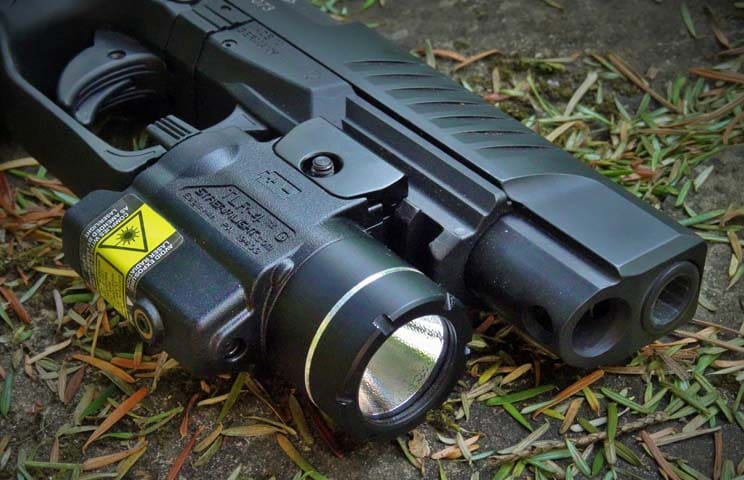
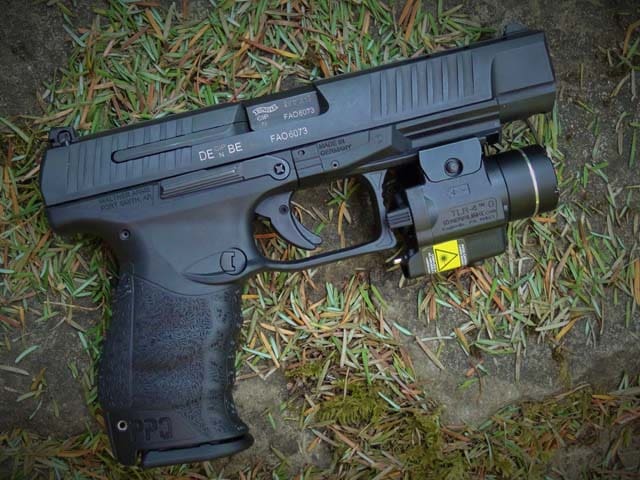


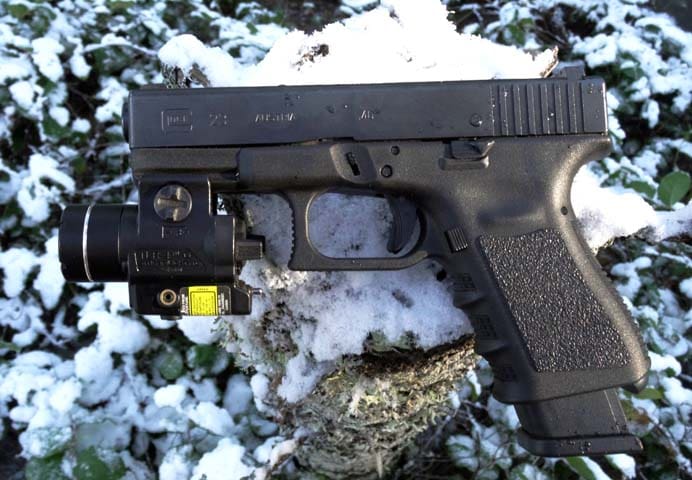



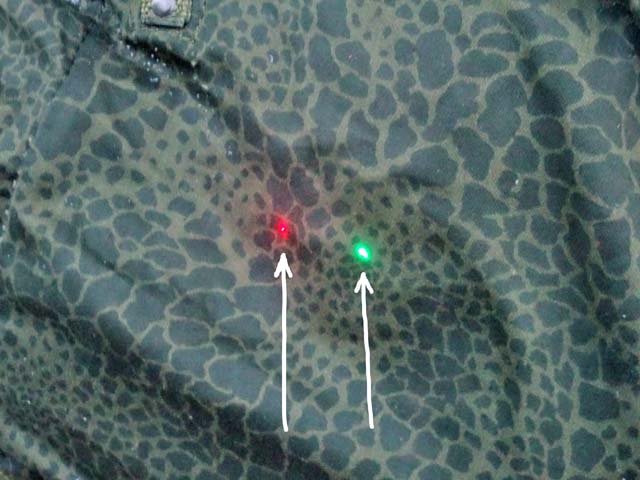

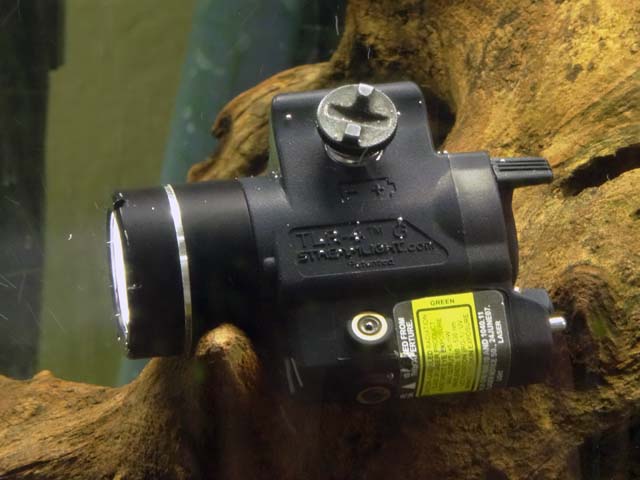
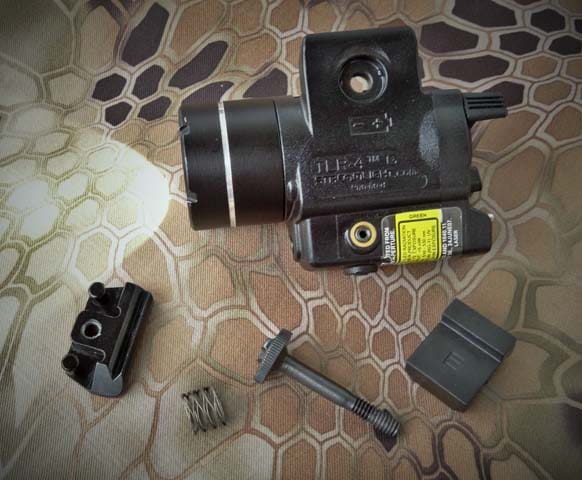



While I have never used one, I object to weapon-mounted flashlights because I just know I would eventually find myself pointing a loaded gun at something I only wanted to illuminate. Good review, tho!
Get one bright enough that you can ‘bounce’ it off any nearby surface for good illumination. Problem solved.
The real question is “Can it be mounted to a baseball bat?”
Hmmm. tactical wooden 1913 rail with bat-slope
My first read of your post, I thought you had typed baseball HAT instead of bat. Then I got to wondering if this would work mounted on a hat. It’s less than 3 oz. Why I am thinking of mounting a laser on my hat I don’t know, but the idea is now stuck in my brain.
Nice review, but you are certainly strict in awarding stars. Kinda nice to see that even though you liked it, you did indicate the things that needed improvement.
Damn fine review! I’ve been shopping around for a light/laser setup. Your review helps a lot!
I have a tlr-4 with the red lazer mounted on my CZ P07. Will never be without one at night.
Way later but thought I’d try. Just picked up a new p07 and was considering the trl4. How has it held up over the years?
I have yet to see a laser useful in bright daylight that is also not horrendously dangerous to your eyesight. It’s called a class III device for a reason.
Good point, in the big scheme of things I could do without the lazer, I would use the light before the lazer any how. My next one will just be a light.
Green light – good
Bigger – bad
Good review Joe.
One item you didn’t mention – what’s different about this Streamlight green laser versus most previous green laser sights is that this is using a ‘direct drive’ true green laser. Most green lasers to date are ‘diode pumped’ – they are actually infrared lasers that use a crystal to double the frequency and it ends up around 500nm which is green. Diode pumped green lasers have a lot of downsides. They are inefficient, burning through batteries quickly, and they are also less reliable and more sensitive to cold temperatures. It’s only in the last year or so that direct drive green lasers are competitive in price with DPSS.
I have to assume Streamlight use a 5mw laser however, so I don’t think you are going to find anything brighter, unless the optics somehow affect collimation of the beam. As the poster above noted, anything more than 5mw is illegal to use without an FDA license (plus you can easily take an eye out)
Not illegal, just unwise. There is no law preventing you from strapping a class IV laser to the side of your gun, you’re just liable for the consequences. The FDA governs the use of lasers for business purposes, but they have passed the buck by issuing a “follow industry best practices” letter. So long as you properly label it, you can sell a cigar lighter based on a class IV laser (and you can buy one online rather easily).
As a rule of thumb for the laser non-initiates.
Class II or below lasers are generally eye safe.
Class III presents am eye hazard.
Class IV presents a skin hazard.
There is nothing above a class IV.
Your post gave me an interesting thought. About lasers or other energy devices and the second amendment. Obviously we all know the 2A does not just mean, “guns”, it means “arms” or “weaponry”. This should include the energy weapons of the future. Now, going back to what you said about illegal lasers, my question is, has the government essentially already banned laser/energy weapons?
No, they haven’t. In fact the US Navy is currently field-testing a high-power laser (effectively, an anti-drone laser) onboard ships at the moment.
The two issues are: the human eye has a ridiculously low damage threshold, compared to other parts of the body, with respect to visible laser light (and nearby wavelengths in the IR and UV); and it’s really hard to package enough energy and power density into a man-portable laser system to make an effective weapon in the make-a-hole-in-something sense.
So a very big problem is, once you’ve made your laser blaster, how do you use it without literally and permanently blinding anyone who even sees “splash” (scattered light) from the beam or the on-target spot? Even if you make it with an eye-safe wavelength, you still have the power and energy density problem.
For instance, a typical AA alkaline battery has more energy stored in it than a 10-round magazine of 5.56 NATO. But the problem is getting it to discharge fast enough to do something useful in a weapons sense.
Interesting. Thanks. I know very little about lasers or other possible future “energy weapons” and I’m trying to learn more.
Thanks for the info, Ace! I learned something!
Any issues with running a light on the PPQ? I have heard some people complain about failures to eject on a PPQ when a light is mounted. I have a PPQ that I have thousands of rounds through with almost no issues, but I have never mounted a light on it.
Jeff, I have not had a single failure of any kind with the Walther PPQM2 and the light has caused no issues.
Good to know about the Steyr. I was going to get one of these, but it looks like I need to do a bit me research first.
I really don’t get why all these combo units have the laser mounted so low, when ideally it should be tucked as close to the bore as possible. Let the white light lens hang low. Who cares?
The Viridian X5L features a green laser tucked in above the light very close to the bore, albeit offset to the side. I do not own one but have handled a buddies FNX-T with the Viridian equipped. A very nice gun gadget but at MSRP I could buy another firearm (nothing really nice but another gun nonetheless).
Sian, You make an excellent point. I agree that it would make a lot more sense to put the laser over the light (to get it closer to the bore axis).
I recommend “indexing” the laser to the barrel so it maintains the same distance from the impact point of the bullet, no matter the range (disregarding bullet drop). Use the laser as a reference point instead of an actual aiming device.
What’s meant by “momentary-on”? Stroboscopic? Because that can be disorienting as hell for both attacker and defender.
Yngyar, the term “momentary on” means that when you push down on the left side of the paddle, it will turn the flashlight on, but only for as long as you hold the paddle down. Its spring loaded to go back to the “off” position as soon as you let go of the paddle. If you want to keep the flashlight in the “on” position without holding on to it, then you move the left side of the paddle to the “up” position.
I have the red TLR4 on my HK P2000 and agree that these are great units. The only problem I had was that Streamlight used blue locktite on the laser adjustment screws, which has caused myself and many others to strip the screws. I had to actually heat the screws up on mine with the tip of a soldering iron to free up the locktite. I take it that Streamlight fixed that issue with this version?
This Streamlight TLR-4G is a great laser sight. Made very well. Very solid materials. This is a GREEN laser by the way. Very happy with this product and you can get it at:
Streamlight TLR-4G
Premium Select Supplies
Great Review! I currently have a TLR-4G on my Glock 30SF, and I am pleased with it. However, I have lost the original spring for the adjustment screw. I made a temporary out of a spring from an old pen, but it’s not the same. I have been trying to find the part name or dimensions to go look around the hardware shops but I can’t get them exact. If you know of any website, suggestions, or the dimensions I would highly appreciate it! Thank you.
Great review!!! I’ll be getting a HS 9 Service Model soon and the TLR-4G is what I plan to get along the way. Btw I’m in the Philippines just in case you guys are wondering about the FA. This would be my first polymer gun and I’m excited. Anyways, thanks for pointing out a few things I never got from YT and other reviews. Appreciate the approach on your review.
ACE nailed it, bringing up the issue of Streamlight TLR-4 having the brightest LASER you can own as a civilian. RED vs Green is more of a Chevy and Ford question; many opinions on which is seen ‘better’ in daylight. NO ADVANTAGES TO USING A LASER IS DAYTIME, which he points out is irrelevant.
PERSONALLY- have experience through a friend’s gunsmith shop with firearms lasers since Crimson Trace began installing on Glocks sent to their factory. SOME work, others not so much. Shop installed, adjusted aim of lasers on guns, did custom mounts, working with local PD and SO as certified armorer for those LEO or departments.
OWN this unit, installed on KelTec, PMR-30 22mag pistol on it’s integral 1913 picatinny rail. Perfect size, Light lens is behind the muzzle (the Streamlight is ONE of a few with Glass lens that are resistant to to damage from muzzle blast.
<<Note: some Lights, muzzle blast removes lens on first battery of shots. Or in short order the muzzle blast so severely scores the LENS of the light,, it is FROSTED, often affecting the brightness of the light, OR it quickly deteriorates the lens to point it falls apart. PLASTIC lens Light units do not as rule hold up very long- even when face of Lens is able to install a full half inch back from Gun Muzzle. Other alternative is LENS of unit mounted a 1/2" PAST the muzzle, which invites scoring or cutting into the body of Light unit. Magnum caliber guns, Glock 20 10mm be surprised how muzzle blast is reminiscent of plasma cutting torch. (similar to units where muzzle blast removes the entire LENS from the Light body. Streamight has GLASS Lens, made from pretty durable material, and same cudo for body material in resisting cutting affects.
LONG Review on Brownell's (and believe on Amazon) for Streamlight TLR-4. Laser bright enough to visibly see RED dot more than 25-yards on gate, tree, or other targets. Old eyes can see the dot, within any distance that a shot is likely to be taken. MORE impressed with the Light,, some have brighter lights, rating in Lumens, etc. IN PRACTICE HOWEVER, this unit if near perfect.. from front porch, can light up the gate of fenced in yard, some 15-20 yards away, enough to IDENTIFY what you are dealing with, BG, GG, MTOBG, or whatever, Even though it's 22mag, PMR-30 is the nighttime go looking weapon due to Light/Laser combo (having 25 rounds loaded, holster with another mag with 25rounds, enough firepower,, nasty 22mag polymer tip ammo, carried empty chamber where a rack slide to chamber is required like Israel military trains)
Only CON I'd give after year of use is it is possible to 'bump' the toggle that changes LASER from off. on or on with Light,, keeping LIGHT & LASER both on (again, you have option of momentary or push lever all way down to STAY on This writer appreciates having LIGHT to identify target to determine if shooting is needed, and LASER for aiming point if you do shoot. Right and left Hand, momentary on/off switch OR full on,,,,,, compact, GLASS LENS on Light, Bright Effective Laser and Light light (or any combo thereof), operated WITHOUT CHANGING HAND ON GUN..
Problem, need another for Glock 20,, that is a problem, since I need another lower or ANOTHER gun since Generation owned does NOT have the 1913 rail on dust cover, like said- a problem. Highly recommend to any and all.
Streamlight as a LIGHT n LASER combo is about a good as it gets. Areas where reviewer dinged one star, I would up their rating one star- except the Laser Toggle (see CON) . Ergonomics, it’s a shame there isn’t a ‘6’ for a 5-Star rating system. Truly is ambidextrous,, right or left hand. If the unit is mounted close to trigger guard, you can do MOMENTARY on with touch of finger, pushing down it stays on unless you let up on finger,, easy to on. off, on,, only having on for instant verification, allowing a move to another position before announcing where you are with LIGHT on.
What key for your PPQ>?
I use key E for my Q5 M1 Match. It fits just like the PPQ 5″ picture above.
Comments are closed.